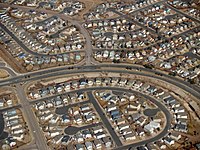
Photo from wikipedia
The development of ‘age-friendly cities’ has become a major area of work in the field of ageing and the built environment. This movement is driven by the observation that cities… Click to show full abstract
The development of ‘age-friendly cities’ has become a major area of work in the field of ageing and the built environment. This movement is driven by the observation that cities are home to an ever-increasing ageing population. Over the past decade, a multitude of age-friendly initiatives have been developed with the aim of making physical and social environments more favourable for older people's well-being, health and ability to live in the community. This article explores ten key questions associated with the age-friendly cities and communities' movement, with a particular focus on the built environment. It provides an overview of the history of the age-friendly cities' movement and the underlying models, the aspects of the built environment that are relevant for age-friendly cities, the ways age-friendliness can be evaluated, and the interactions between age-friendly cities initiatives and other strategic agendas such as smart cities. The paper concludes by discussing future perspectives and possible directions for further development of the age-friendly movement.
Journal Title: Building and Environment
Year Published: 2021
Link to full text (if available)
Share on Social Media: Sign Up to like & get
recommendations!